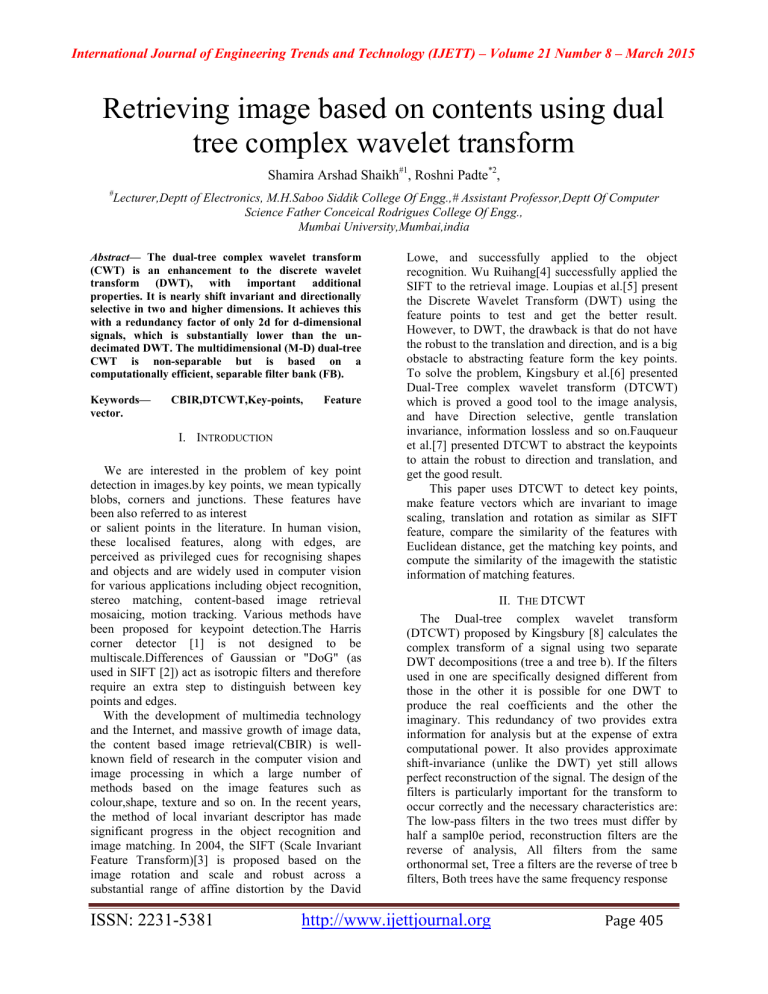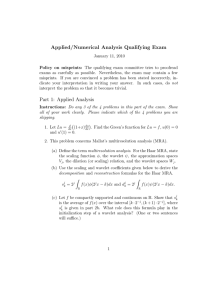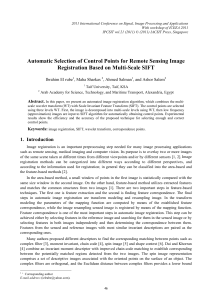Retrieving image based on contents using dual tree complex wavelet transform

International Journal of Engineering Trends and Technology (IJETT) – Volume 21 Number 8 – March 2015
Retrieving image based on contents using dual tree complex wavelet transform
Shamira Arshad Shaikh
#1
, Roshni Padte
*2
,
#
Lecturer,Deptt of Electronics, M.H.Saboo Siddik College Of Engg.,# Assistant Professor,Deptt Of Computer
Science Father Conceical Rodrigues College Of Engg.,
Mumbai University,Mumbai,india
Abstract
— The dual-tree complex wavelet transform
(CWT) is an enhancement to the discrete wavelet transform (DWT), with important additional properties. It is nearly shift invariant and directionally selective in two and higher dimensions. It achieves this with a redundancy factor of only 2d for d-dimensional signals, which is substantially lower than the undecimated DWT. The multidimensional (M-D) dual-tree
CWT is non-separable but is based on a computationally efficient, separable filter bank (FB).
Keywords— CBIR,DTCWT,Key-points, Feature vector.
I.
I NTRODUCTION
We are interested in the problem of key point detection in images.by key points, we mean typically blobs, corners and junctions. These features have been also referred to as interest or salient points in the literature. In human vision, these localised features, along with edges, are perceived as privileged cues for recognising shapes and objects and are widely used in computer vision for various applications including object recognition, stereo matching, content-based image retrieval mosaicing, motion tracking. Various methods have been proposed for keypoint detection.The Harris corner detector [1] is not designed to be multiscale.Differences of Gaussian or "DoG" (as used in SIFT [2]) act as isotropic filters and therefore require an extra step to distinguish between key points and edges.
With the development of multimedia technology and the Internet, and massive growth of image data, the content based image retrieval(CBIR) is wellknown field of research in the computer vision and image processing in which a large number of methods based on the image features such as colour,shape, texture and so on. In the recent years, the method of local invariant descriptor has made significant progress in the object recognition and image matching. In 2004, the SIFT (Scale Invariant
Feature Transform)[3] is proposed based on the image rotation and scale and robust across a substantial range of affine distortion by the David
Lowe, and successfully applied to the object recognition. Wu Ruihang[4] successfully applied the
SIFT to the retrieval image. Loupias et al.[5] present the Discrete Wavelet Transform (DWT) using the feature points to test and get the better result.
However, to DWT, the drawback is that do not have the robust to the translation and direction, and is a big obstacle to abstracting feature form the key points.
To solve the problem, Kingsbury et al.[6] presented
Dual-Tree complex wavelet transform (DTCWT) which is proved a good tool to the image analysis, and have Direction selective, gentle translation invariance, information lossless and so on.Fauqueur et al.[7] presented DTCWT to abstract the keypoints to attain the robust to direction and translation, and get the good result.
This paper uses DTCWT to detect key points, make feature vectors which are invariant to image scaling, translation and rotation as similar as SIFT feature, compare the similarity of the features with
Euclidean distance, get the matching key points, and compute the similarity of the imagewith the statistic information of matching features.
The
II.
Dual-tree
T HE DTCWT complex wavelet transform
(DTCWT) proposed by Kingsbury [8] calculates the complex transform of a signal using two separate
DWT decompositions (tree a and tree b). If the filters used in one are specifically designed different from those in the other it is possible for one DWT to produce the real coefficients and the other the imaginary. This redundancy of two provides extra information for analysis but at the expense of extra computational power. It also provides approximate shift-invariance (unlike the DWT) yet still allows perfect reconstruction of the signal. The design of the filters is particularly important for the transform to occur correctly and the necessary characteristics are:
The low-pass filters in the two trees must differ by half a sampl0e period, reconstruction filters are the reverse of analysis, All filters from the same orthonormal set, Tree a filters are the reverse of tree b filters, Both trees have the same frequency response
ISSN: 2231-5381 http://www.ijettjournal.org
Page 405
International Journal of Engineering Trends and Technology (IJETT) – Volume 21 Number 8 – March 2015
The DTCWT decomposition of an n×n image results in a decimated dyadic decomposition into i=1...m scales, where each scale is of dimension n/2i
× n/2i. At each decimated location of each scale, we have a set S of 6 complex coefficients, denoted as
S={ρ1eiθ1 , ..., ρ6eiθ6 }, corresponding to responses to the 6 subband orientations, namely:
(±15°,±45°,±75°).
Fig. 1. Block diagram for DTCWT
Fig 2.Dtcwt real part and imaginary part
III. DETECTING KEY-POINTS
A.
Detecting Key-Points using DTCWT
In 1998, the DTCWT [7] was proposed by
Kingsbury etal and was shown to be a particularly suitable tool for image analysis as it is directionally selective (see figure 1), approximately shift invariant, limited redundancy, and computing efficiency. That is, any finite energy analog signal x(t) can be decomposed in terms of wavelets and scaling functions via[8]:
The scaling coefficients and wavelet coefficientsare computed via the inner products. They provide atime-frequency analysis of the signal by measuring itsfrequency content (controlled by the scale factor j) atdifferent times (controlled by the time shift n).
DTCWT is implemented by 2 Discrete Wavelet
Trees to compute real part and imaginary part. They work on the row and column of image. Each decomposition, we can get 2 low frequency sub bands, and , and six orientations (±15°,±45°,±75°) high frequency sub bands,, m=1,2,…,6.
B.
.Detecting Key-Points using DTCWT
At this stage, we start to describe the algorithm:
1) The DTCWT decomposition of an image results in a decimated dyadic decomposition into scales, where each scale is of size. At each decimated location of each scale, we have a set C of 6 complex coefficients, denoted as, corresponding to responses to the 6 subbandsorientations, namely:15°,45°,75°,105°,135°,165°,see Figure 2
.
C=
ρ1ρ3+ρ1ρ4+ρ1ρ5+ρ2ρ4+ρ2ρ5+ρ2ρ6+ρ3ρ5+ρ3ρ6+ρ4
ρ6
2) The following key point energy measure that we
Propose is based on the product of all six sub bandsmagnitudes. Parametersα and β control the relative weightof scales in the accumulated map
(seebelow).According to the paper [8] , we let
α=1,β=1/4. We produce m decimatedenergy maps
,M 1 ...M
m by calculating E(c) [9] for all the scale of the coefficients at each
DTCWTdecomposition.
-eq(2)
3) We define the accumulated energy map(AEM) of the image product of all six sub bandsmagnitudes: as the sum of the interpolatedmaps from scales 1 to m:
A= -eq(3)
Given a map, we denote as the 2D image size (i.e. up sampling by a factor of ).In an interpolated map , a high energy key point produces a high Gaussian peak whose variance and inverse curvature are proportional to the scale factor squared. As a result, the accumulated map is a mixture of Gaussian centered about each saliency. The accumulated map corresponding to the Figure 4(a) which is a test image we create is shown in figure 3 as a surface plot.
DTCWT descriptors are show in Figure 4(b),and
SIFT descriptors are shown in Figure 4(c).For comparison, DTCWT descriptors meet human vision
ISSN: 2231-5381 http://www.ijettjournal.org
Page 406
International Journal of Engineering Trends and Technology (IJETT) – Volume 21 Number 8 – March 2015 more than SIFT descriptors do.
Fig 3.AEM shown as a surface plot
Fig 5. Shows Query image applied with scaling factor = 1
=1
Rotation = 1 and translation for X=1 and Y shift
Computational Time = 0.2434
Fig 4.(a)Test image;(b)Detected key points with
DTCWT;(c) Detected key points with SIFT
III.
F EATURE V ECTOR C ONSTRUCTING
After extract the information of key point from image, we make use of neighbour pixels, calculate direction parameter of each key point with the distribution of neighbour pixels’ gradient, and so that the key point possess the ability of rotation invariant.
Sampling the neighbour pixels with the key point as centre, count the gradient direction with histogram.
The peak point of histogram is taken as the main direction of the key point. The range of the gradient direction histogram is 0-360, if we quantitative 10 degrees as one bin, there are totally 36 bins.[9] is a sample of 7 bins of gradient direction histogram.
.
IV.
EXPERIMENT
This experiment shows a retrieved image which is invariant of translation rotation and scaling using
DTCWT. factor = 1
Rotation = 5 and translation for X=1 and Y shift
=1
Fig 6. Shows Query image applied with scaling
Computational Time = 0.2617
Fig 7. Shows Query image applied with scaling factor = 1
=1
Rotation = 5 and translation for X=1 and Y shift
Computational Time = 0.2668
ISSN: 2231-5381 http://www.ijettjournal.org
Page 407
International Journal of Engineering Trends and Technology (IJETT) – Volume 21 Number 8 – March 2015
Fig.8 Shows image applied with all the three different factors i.e.rotational, scaling, and translation of an image
V.
RESULT
Image retrieved in each case is the true image from database and the same image for each case, result can be shown as Fig 9, Result is invariant of translation, rotation and scaling
R EFERENCES
[1] Lowe D, “Distinctive image features from scale-invariant key points, “International Journal on Computer Vision,
2004, 60(2),pp.91-110 .
[2]
WU Rui hang, LI Shao zi, ZOU Feng mei , “Image retrieval based on SIFT features,” Application Research of
Computers, 2008,25(2),pp.478-481���
[3] E.Loupias,N.Sebe,S.Bres,and J-M.Jolion, “Wavelet-based salient points for image retrieval,”IEEE International
Conference on Image Processing,2000(2),pp.518-521
[4]
N.G.Kingsbury, “Complex wavelets for shift invariant analysis and filtering of signals,”Journal of Applied and
Computational Harmonic Analysis,vol.10,no.3,May
2001,pp.234-253
[5]
Fauqueur, J., Kingsbury, N., Anderson, R., “Multiscale
Keypoint
Detection using the Dual-Tree Complex Wavelet
Transform, “Image Processing, 2006 IEEE International
Conference on 8 Oct.2006,pp.1625 – 1628
[6] Ivan W.Selesnick,Richard G.Baraniuk,and Nick
G.Kingsbury, “The
Dual-Tree Complex Wavelet Transform,” IEEE SIGNAL
PROCESSING MAGAZINE , NOV 2005,pp.123-150
[7]
Fauqueur, J., Kingsbury, N., Anderson, R., “Multiscale
Keypoint
Detection using the Dual-Tree Complex Wavelet
Transform, “Image
Processing, 2006 IEEE International Conference on 8-11
Oct.
2006,pp.1625 – 1628
[8]
Lowe D, “Distinctive image features from scale-invariant key points,”
International Journal on Computer Vision, 2004, 60(2), pp.91-110.
[9] Content based image retrieval system using dtcwt,
Fig.9 Recognized Image
VI.
CONCLUSION
In above proposed system recognized image is invariant of translation rotation and scaling, and we can observe by result as we rotational factor is increasing keeping two other factor constant computational time is also increasing, in this way we can conclude that DTCWT is good algorithm as compared to SIFT and precise result can be implemented, the only drawback of increasing computational time
ISSN: 2231-5381 http://www.ijettjournal.org
Page 408





